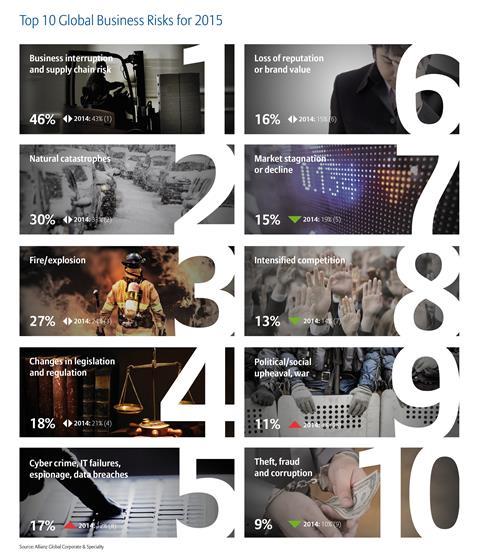Loss of reputation and brand value and cyber crime have both leapt up the risk table to second and third place respectively, after business interruption

Businesses face new challenges from a rise of disruptive scenarios in an increasingly interconnected corporate environment, according to the fourth Allianz Risk Barometer 2015.
The survey, conducted among more than 500 global risk managers and corporate insurance experts found that globally traditional industrial risks such as business interruption and supply chain risk (46% of responses), natural catastrophes (30%) and fire and explosion (27%) continue to concern risk experts.
Cyber (17%) and political risks (11%) went up the rankings most.
Chris Fischer Hirs, chief executive of Allianz Global Corporate & Specialty (AGCS) said: “The growing interdependency of many industries and processes means businesses are now exposed to an increasing number of disruptive scenarios. Negative effects can quickly multiply. One risk can lead to several others. Natural catastrophes or cyber attacks can cause business interruption not only for one company, but to entire sectors or critical infrastructure.
“Risk management must reflect this new reality. Identifying the effect of any interconnectivity early can mitigate or help prevent losses. It is also essential to foster cross-functional collaboration within companies to tackle modern risks.”
In the UK, loss of reputation and brand value and cyber crime have leapt up the risk table to second and third place respectively, after business interruption.
As the recent hacking attack on Sony Pictures demonstrates, cyber crimes typically come with additional reputation fall out that can be even more damaging. Cyber crime is not only growing but evolving, for example, the amount of malware and malicious software for Android devices has rocketed by 400% since 2012, AGCS has said.
Although social media have been integral in building brands, they can be as effective at damaging reputations. In the UK, market fluctuations such as interest rates and foreign exchange rates continue to be a concern, ranking ninth in the table. In addition, austerity measures make a first time entry at 10th place – a sign that political uncertainty in the UK could last beyond this year’s general election in May.
Budget constraints and siloed knowledge impair cyber protection
The risk of cyber crime and IT failures continues its rapid rise in the Allianz Risk Barometer, moving into the top five business risks globally for the first time (in 2014, cyber risks ranked eight and in 2013 15th). In Germany, the UK and the US, cyber risks are now among the top three corporate risks. Loss of reputation (61%) and business interruption (49%) are regarded as the main causes of economic loss following an incident.
Although awareness of cyber risks is increasing, many companies are still underestimating the different effects, according to 73% of responses. Budgetary constraints are another reason why companies are not better prepared to combat cyber risks.
Jens Krickhahn, practice leader cyber and fidelity at AGCS Financial Lines, Germany and Central Europe, said: “Cyber risks are very complex. Different stakeholders such as IT security architects and business continuity managers need to share their knowledge to identify and evaluate threat scenarios.
“Previously siloed knowledge needs to be incorporated in one think tank that can look at risks holistically. The human factor should also not be underestimated, as employees can cause IT security incidents, inadvertently and deliberately.”
Political risks on the rise
Political/social upheaval is a much bigger concern for businesses in the 2015 Allianz Risk Barometer, rising nine positions to ninth overall, compared to last year’s survey. The risk appears in the top 10 risks in the Europe, the Middle East and Africa (EMEA) for the first time in eighth place. It is also a new entrant in the top 10 risks for Brazil and has become one of the top three risks in Russia and Switzerland, ranking as the top business concern in Ukraine.
Furthermore, it is the second top cause of supply chain disruption (53%) after natural catastrophes.
According to newly appointed Christof Bentele, head of crisis management at AGCS, the geo-political situation continues to deteriorate, making companies more vulnerable: “Country risk levels change more often and more frequently than they did in the past, which makes risk assessment more volatile.”
Another source of political tension in 2015 could come from lower oil prices, which are going to strain the budgets of countries heavily dependent on oil revenues. Combating political risks and terrorism are identified as top business risk management challenges in the next five years.
More severe business interruption implications
For the third year in succession, business interruption (BI) and supply chain risk is the top peril in the Risk Barometer with almost half (46%) of the responses rating this as one of the three most important risks for companies, up 3% year on year. Fire/explosion (43%) and natural catastrophes (41%) are the major causes of BI companies fear most.
The consequences of the subsequent disruption potentially affecting a company, its suppliers and customers often outweigh the physical damage. At €1.57m, the average business interruption insurance claim is already 32% higher than the average direct property damage claim.
Regional trends: talent shortage fears increasing
Although the top three risks, namely BI/supply chain, natural catastrophes and fire and explosion, are identical across the EMEA, the Americas and Asia-Pacific regions for the third successive year, there are regional differences. Cyber risk has risen in EMEA’s and Americas’ top 10 risks, but it does not appear in the top 10 Asia-Pacific risks, and the insurer suggests that many companies are not grasping the full consequences of the potential risks involved. A combination of shortage of skilled talent, together with an aging workforce, is deemed an increasing concern and is a new entry in the top 10 risks in the US.
Across Asia-Pacific, companies are now more concerned about the trading environment than 12 months ago with the prospect of market stagnation or decline entering the top 10 risks.
Industry trends: competition worries shipping, regulation concerns financial services
The effect of natural catastrophes (42%) such as earthquakes remains the top risk for the engineering and construction sector. BI (68%) continues to be the top risk, with manufacturers even more concerned than 12 months ago (60%), driven by the fact that the potential for large claims in certain sectors such as semiconductor or automotive is increasing. Changes in legislation and regulation (33%) remain the top concerns for financial services, reflecting increasing supervisory intervention around the globe. The shipping sector is concerned about intensified competition (29%), and theft (47%) worries the transportation industry.
Dual challenge: climate change and disruptive technologies
Climate change and natural catastrophes and so-called “disruptive technologies” such as 3D-printing or nanotechnology dominate the long-term risk agenda.
Axel Theis, member of Allianz’s board, said: “Companies can expect to face further disruption from technological innovation, while also being exposed to climate change impact as an underlying risk that is not within their direct control.
“Individual best practice, together with collaboration across companies, industries and regions can help mitigate environmental damage and create future safety, growth and innovation in a more sustainable world.”




















No comments yet